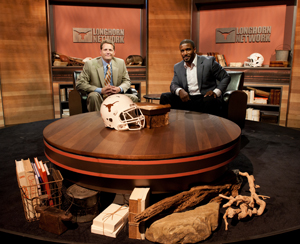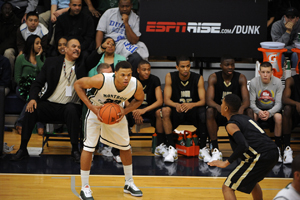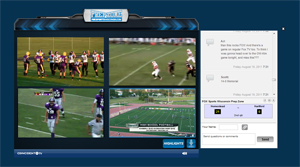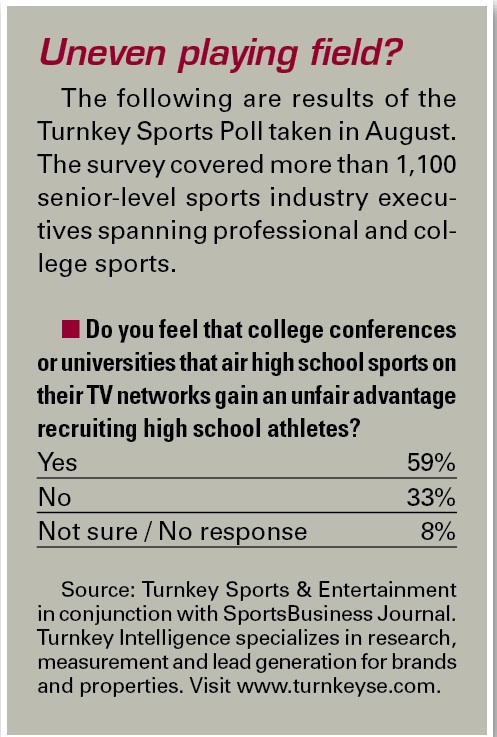The growth of high school programming has raised some thorny questions over who should be allowed to carry such content, especially with the rise of networks affiliated with college conferences or individual schools.
For example, worried about potential recruiting advantages, NCAA rules prohibit the Longhorn Network — a channel fully owned by ESPN — from showing high school games.
Yet NCAA rules can’t stop any of ESPN’s national channels from scheduling high school games that involve Texas recruits. And what if ESPN decides to rebrand the Longhorn Network to something, like, ESPN Texas which doesn’t use the university’s marks? Would that channel have to adhere to NCAA regulations?
 |
JOE FARAONI / ESPN
The NCAA ruled that networks affiliated with conferences or universities, such as the new Longhorn Network, can’t show high school games. |
High school programming on television and online is exploding at such a rate that new rules seem outdated almost immediately.
“When we head down the road of what started with sports networks, then it went into conference networks and now we’re looking at school networks,” said Kim Carver, The Mtn.’s vice president and general manager. “Things are evolving faster than we can keep up with.”
Last month, the NCAA convened a meeting with college sports networks and high school associations to try to make sense of the rules. At issue was the Longhorn Network’s original programming plan, which was to feature high school games and highlights. Following the meeting, the NCAA affirmed its rules that TV channels affiliated with conferences or universities are not allowed to show high school games.
“It’s one of those things that gets into recruiting issues,” Pac-12 Commissioner Larry Scott said. “Especially in this environment and climate, I don’t think it would be particularly wise.”
The Aug. 22 meeting in Indianapolis came at a time when high school sports coverage is taking up a bigger part of sports networks’ schedules than ever — a low-cost programming staple, particularly with regional sports networks. RSNs generally don’t view high school sports as a big profit center. But high school programming gives the channels a way to ingratiate themselves to the local markets.
National networks, particularly ESPN, generally view high school sports as a way to highlight name schools and blue-chip prospects. That’s where the problems with high school programming on conference and college networks come into play.
To date, neither the Big Ten Network nor The Mtn. have aired high school games. Neither channel plans to put high school games on its schedule. The Pac-12’s planned suite of networks also has no plans to show high school games. These decisions have as much to do with logistics as anything else. With conference networks serving so many markets, which high school games would they choose?
Real questions arise over how much jurisdiction the NCAA has to enforce these rules. The Big Ten Network, for example, is majority owned by Fox; The Mtn. is jointly owned by CBS and NBCUniversal; and the Longhorn Network is fully owned by ESPN.
“There’s a basic principle with the NCAA around recruiting of agency,” Scott said. “It would be very clear to us that ESPN is an agent of the University of Texas. Fox is an agent of the Big Ten from a recruiting perspective. Ownership doesn’t matter.”
The Mtn.’s Carver said she would not make any decisions that would harm Mountain West Conference schools.
But sometimes adhering to those rules could put conference or school networks at a competitive disadvantage. SportsNet New York, for example, is the official television home of the University of Connecticut’s football and men’s basketball teams. NCAA rules don’t apply to SNY because the network isn’t specifically branded after the school.
“The NCAA was not interested in any way in discussing or restricting or even addressing the notion of what other entities can do,” said Burke Magnus, ESPN’s senior vice president of college sports programming. “That horse left the barn a long time ago. They were simply focused on networks and platforms that were branded with conference or institutional marks.”
It’s all in the branding
High school programming on conference or school networks has not been a problem yet because none of the networks has experimented with it.
Since The Mtn. launched in 2006 as a venture between NBCUniversal and CBS, the channel has never considered carrying high school programming.
“We have so many states and so many cities, where would I even start anyway?” Carver asked. “But if high school programming came into us, I would look at it.”
That’s a situation that Carver believes will happen soon. Over the next several years, she predicted, high schools will become better equipped at producing their own games, which would mean a steady flow of content to channels like hers.
“There are already high school websites that are streaming,” she said. “The content is going to be there.”
Scott sounded a similar concern. The Pac-12 Conference has no plans to put high school games on its TV channels’ schedules, and Scott said he has no interest in doing so. But if others start to do it, Scott said he would reluctantly have to follow suit.
“If the NCAA ever allows it, and if other conferences or individual schools and their affiliated networks ever broadcast it, then we would, in all likelihood,” Scott said. “It’s not part of our plan. It never has been. But to the extent others are doing it, there’d be a sense of obligation we’d have to our high school associations to support them.”
Longhorn Network executives say they will bide by the restriction on high school games, even if they were part of their original plans. The network still plans to show high school highlights and cover high school sports as part of its news and information programming.
“We don’t have any significant plans to do that in a wide manner,” Magnus said. “It’s not highlighting Texas recruits, but doing it by an objective criterion selection, like the top 10 teams in all the divisions across the state. The NCAA will be watching how we execute it, of course. But they understood that it was not something they have intended to restrict.”
Big Ten Network did not make its executives available for this story. But they said carrying high school games is not part of the network’s current plans.
The ESPN experience
The hullabaloo over high school games started in June, when ESPN’s vice president of programming and acquisitions, Dave Brown, publicly suggested that the Longhorn Network would carry games that included Texas recruits. His comments created a firestorm and led to last month’s NCAA meeting in Indianapolis.
 |
ESPN
ESPN has made high school sports a growing part of its programming, focusing mainly on widely recognized schools and prized recruits. |
ESPN executives say that Brown overstated how often the Longhorn Network would carry high school games, which would have been a small part of the network’s schedule. They say the “vast majority” of high school games would not have involved any potential recruits.
But Brown’s comments mimic the way high school programming has grown on ESPN’s national networks, where ESPN has focused on the most widely recognized schools and the prized recruits.
“From a national perspective, we’re really focusing primarily on the blue-chip recruits and the high-profile, top-ranked teams,” Magnus said of ESPN’s national philosophy. “That’s the approach we took during the early days at ESPNU, and it continues to be our approach broadly for a national game.”
The strategy was different for a more local channel like the Longhorn Network, Magnus said. Magnus described high school football as part of the fabric of the state of Texas, which is something a local channel would want to document.
“We’ve said all along that we thought this network, while primarily focused on University of Texas athletics, certainly had a vision to go beyond that, whether it was diving into life in Austin or academic and cultural issues both on campus and off,” he said. “To the extent that this network reflected the interest of the people of the state of Texas, we considered high school athletics, particularly high school football, as an interesting component to blend in with all the other content on Longhorn Network. Whether people choose to believe this or not, it was not solely from the perspective of highlighting high-profile Texas recruits.”
Ironically, the ruling to ban the Longhorn Network from carrying high school games won’t hurt much, since Texas’ University Interscholastic League does not allow Friday night games to be televised.
What about other nets?
The NCAA may have kept high school games off conference and college channels, but that content is growing rapidly on regional sports networks, like SNY.
The RSN hosts and televises a high school basketball tournament in New York every year with popular teams like St. Anthony’s. SNY uses the tournament to aid the community, spending profits from the event to fund schools and college scholarships, said SNY
 |
| Fox Sports Net will stream more than 230 high school events this year in Wisconsin. |
President Steve Raab.
“We don’t have a high school strategy; it’s a community strategy,” Raab said. “If and when the SNY Invitational gets to a profitable point, our intent is to plow that profit back into the schools.”
Fox Sports Net also is expanding its high school footprint in various regions. In Texas, for example, it launched a six-hour Friday night show that offers high school scores and highlights. Its high school business is profitable, “but not by much,” said Jon Heidtke, senior vice president and general manager ofFox Sports Southwest.
“In Texas, high school football is part of the DNA of these communities and of our coverage,” Heidtke said. “We realize how important it is. We put a lot of effort into it. We consider it one of our tentpole
programming.”
In Wisconsin, FSN will stream more than 230 high school events this year. More than 90 of those events will be repackaged for linear TV. That initiative is certain to grow, especially as high schools begin to produce more of their content and more companies enter the space, said Mike Dimond, senior vice president and general manager of Fox Sports North and Wisconsin. FS Wisconsin has partnered with Coincident TV and SnappyTV to aid the streaming effort.
“It’s an investment that we’re making to the future,” Dimond said. “It’s not an overnight profitability.”
In New York, Cablevision launched a cable channel entirely devoted to high school events, MSG Varsity, in 2009. The channel was launched as a way for the cable operator to retain customers, since it’s not available on satellite. The channel still is growing, having launched daily sports news shows this fall that are regionalized to its New York City, Long Island, New Jersey and Connecticut/Westchester County/Hudson Valley subscribers.
By all accounts, the amount of high school sports on television and online will continue to grow.
“I just expect more: more games on more platforms locally, regionally and nationally,” ESPN’s Magnus said. “Our activities as a company are getting more localized as well. You’ll see us apply that to high school athletics.”







